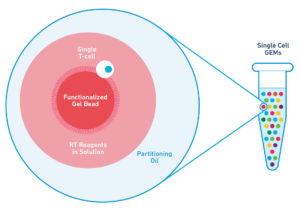
The 10X Genomics Chromium System, provides a reagent delivery method that enables thousands of micro-reactions in parallel, each containing an identifying barcode such that all sequencing library fragments produced within a partition share a common barcode.
Gel Beads, containing barcoded oligonucleotides, are mixed with a sample, which can be high molecular weight (HMW) DNA, cells, or nuclei. Gel Beads and samples are then added to an oil-surfactant solution to create Gel Beads in EMulsion (GEMs), which act as individual reaction vesicles in which the Gel Beads are dissolved and the sample is barcoded. Barcoded products are pooled for downstream reactions to create short-read sequencer compatible libraries. After sequencing, the resulting barcoded short read sequences are analyzed with bioinformatics that use the barcode information to map reads back to their original HMW DNA, single cell, or single nucleus of origin.
SINGLE CELL TRANSCRIPTOMICS

Partitioning of Individual cells.
The Chromium System also enables single cell transcriptional RNA profiling of hundreds to tens of thousands of individual single cells. Single cell suspensions loaded onto the system are partitioned into GEMs, where transcripts are tagged with cell-specific barcodes. The barcoded cDNA is then pooled for downstream processing and library preparation. For immune repertoire profiling, the cDNA undergoes targeted enrichment for T- or B-cell receptor transcripts prior to library preparation. After sequencing, downstream bioinformatics tools use the cellular barcodes to group transcripts that originated from the same cell, revealing the transcriptome and/or the full-length T- or B-cell receptor sequences of each individual cell.
Single Cell Gene Expression
High-throughput, single cell gene expression measurements that enable discovery of gene expression dynamics and molecular profiling of individual cells and cell types.
Gene Expression & cell-surface protein (using Feature Barcoding technology)
Seamlessly measure both gene- and cell surface protein-expression in the same cell to identify protein isoforms, detect protein for low abundance transcripts, and further increase phenotypic specificity.
Gene Expression CRISPR screening (using Feature Barcoding technology)
Identify perturbations of cellular transcripts mediated by hundreds of different CRISPR sgRNAs in one experiment.
Single Cell Immune Profiling
Tool for profiling full-length paired V(D)J transcripts from hundreds to tens of thousands of lymphocytes. The new solution enables assembly of full-length V(D)J sequences on a cell-by-cell basis, providing high resolution insights into the adaptive immune system.
Single Cell Immune Profiling & cell-surface protein (using Feature Barcoding technology)
Seamlessly combine cell surface protein expression measurements along with immune repertoire and gene expression measurements from the same single cell.
Single Cell Immune Profiling & antigen specificity (using Feature Barcoding technology)
Determine antigen specificity of single T cells with Feature Barcode peptide-MHC multimers to study the dynamic interactions between lymphocytes and antigens. Unveil a new understanding of the adaptive immune response in hundreds to tens of thousands of lymphocytes.
